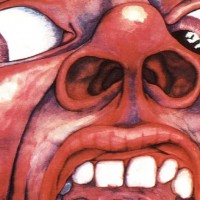The problem any incarnation of this band has faced is getting King Crimson’s music heard by more than its legion of die-hard fans. The appeal of the music is more in the power of the mathematical precision with which Crimson’s members undertake each piece. As such, it’s generally geared toward people who prefer to “listen” to music, as opposed to those who “like to rock.” For all the effort the band puts in “rocking out,” the result is nearly always something more akin to rock-via-modern-classical music than something from the gut.
Apparently, it must be very difficult to rock out when you play in odd time signatures–- the same kind of time signatures that prevents the other thing associated with rock, dancing. Dancing to King Crimson, while not entirely improbable, is generally unlikely and would certainly have to be the free-form, aimless “interpretive” dancing that isn’t inhibited by an ever-changing beat. Paired with the kind of music Crimson generally puts out (“intellectual”) the result would, at the very least, be entertaining to watch.
Much of the efforts of the group’s modern era, starting with 1981’s Discipline, were on intricate, interlocking guitar pieces inspired by Gamelan music that King Crimson’s Robert Fripp became fascinated with at the time. Instead of simply playing melodies, the guitarists would often build patterns around each other, weaving in and out of each other’s notes.
The result, to the casual listener, is a lot of seemingly very repetitive music. To the attentive listener is revealed fascinating textures, almost the musical equivalent of fractal imagery. Again, not something that fills the dance floor. Think Philip Glass, filtered through rock instrumentation, and you are not far from what much of these lineups produced. Think Talking Heads and Philip Glass, and you’ve just about nailed the sound perfectly.
Fripp may not have been the “captain” of the group then, but he was at least the rudder. (Fripp will happily debate you on this point.) He’d steer the old ship King Crimson out of storage whenever he felt there is something for the band to address. Just what that might be was always a mystery, but its roots were generally in whatever rock-related music was garnering attention at the time. King Crimson emerged as if to say, “Well, yeah, you’re doing it, but let me show you how it could have been done.”
In keeping, Crimson disappeared in the mid-1980s, only to pop up again 10 years later with metal on the band’s minds – metal, in the form of the “alternative” rock that was popular at the time, that is.
King Crimson slipped back into the public eye, limited though it may be for them, and presented its take on the sludgy, cacophonous guitar-rock that permeated the airwaves. It wouldn’t last long, but they toured behind the mid-1990s project Thrak for several years before succumbing to its own weight. Crimson attempted so much, but had so little to move it forward, that efforts to produce a second album ultimately failed.
The embryonic song structures, however, did carry forward into a series of splinter groups that applied the latest and greatest in music technology, utilizing the very equipment and sounds that propelled their nemesis – techno, a music so stiff and unchanging that “live” performers were often simply cueing up patches on their laptops – but did so in concert with improvised extensions of the Thrak band’s final compositions.
These projects, or ProjeKcts as they were called, were a proving ground for the next step, and promised great things. Unfortunately, a severe case of cold-feet ensued while Crimson prepared 2000’s The ConstruKction of Light, and the result was a dreary, dismal, and at times, downright boring album. The ProjeKcts promised, and often delivered, a bold new step not only for King Crimson but for rock music in general.
The ConstruKction of Light wound up being more about hindsight, deriving some its “new” material from reworkings of past glories, and utilizing very little of the exciting material the ProjeKcts helped develop. Most of all, the very attitude of the ProjeKcts was entirely missing, an element that proved key to the success of this band’s material.
The King Crimson lineup of Fripp, Adrian Belew, Pat Mastelotto and Trey Gunn had clearly learned from past mistakes as they released the follow-up The Power to Believe on March 4, 2003.
Rather than revisit an older song, they pushed it a step further: “Elektric,” for example, is an obvious nod to the most successful piece from the previous album, the title track “The ConstruKction of Light,” albeit more paranoid and frantic – surely a reflection of the atmosphere in the wake of events like Sept. 11 and the wars in Afghanistan and Iraq. Instead of simply redoing that song, they twisted and turned it inside out, revealing new textures and motifs to play in and around.
“Dangerous Curves,” a piece developed live on the ConstruKction tour, is an ever-building crescendo, broken in spots by tension-relieving passages, and mimics the kind of anthems seen in war movies. And where Discipline was Talking Heads filtered through Philip Glass, “Level Five” is Black Sabbath meets Glass – and specifically, “Iron Man.” Of course, the outcome is considerably more menacing than either Talking Heads or Philip Glass.
“Eyes Wide Open” is this band’s “One Time” for those familiar with Thrak – or “Heartbeat,” if you prefer the ’80s band. The song is one of the few moments of innocent optimism in a very dark album, and even then it’s a good deal more dark than the previous bands’ offerings. The only let down on The Power to Believe is “Facts of Life,” and that’s not really even bad. It just doesn’t fit well in the flow of the album. The album’s lineup might have been that much stronger had it been relegated more toward the beginning rather than smack-dab in the middle.
As was often the case with this late-model King Crimson, the vocal material tends to clash with the instrumental material. The instrumentals are particularly meaty and climactic sounding, while the vocal stuff tends to be lighter. Taken as a whole, however, The Power to Believe feels like a buildup to an apocalypse – an innocent’s view of the instruments of war being assembled before his very eyes. The outcome of that war is left to the listener’s imagination.
On more technical notes, the production is stunning, with instruments panned and spaced out on the soundstage in intriguing ways that have never before been heard on a King Crimson album. The actual sound on The Power to Believe is also very modern, thanks to the guidance of the producer: the mysterious “Machine,” whose credits include production/engineering work on White Zombie and Pitchshifter albums in the past.
His experience shows. While the actual music may not be shocking and new, the production values certainly were – and Machine injected a bit of new energy by taking King Crimson’s penchant for new technology a step further, clipping and distorting drums, and filling in the background with unusual ambient noise.
For those who were excited by the promise the ProjeKcts seemed to predict in future Crimson releases, but were let down by the resulting backslide of ConstruKction of Light, this was the album for you. Of course, The Power to Believe wasn’t entirely new terrain for the band. Much of the ’80s interlocking-guitar motifs are present, as are the careening crescendos so representative of the ’70s versions of the band. But they were presented in a way that made them exciting and bold – and most of all, new to ears that have heard it all many times before.
- King Crimson’s Brief But Important Double-Trio Era Peaked With ‘Thrak’ - April 14, 2025
- How David Bowie’s ‘Reality’ Stood Out For What It Was Not - September 29, 2023
- Metallica’s ‘St. Anger’ Was Always Much Better Than They Said - June 8, 2023



Great album. My second favorite. Trey left at the top of Crim’s game.
On TCoL, i often wonder if they should have left off prozac blues, frying pan, and oyster soup… Even the titles seem to belong on a belew solo album… The rest of the album is KC allright.
I’ve always thought that the problem with TCoL was the sound, not the material. So much of that album was gangbusters in concert, but the overall sound on the record was too electronic, too sterile for it to take flight (and Fripp seems to have admitted that his attention was far more focused on playing than on production for this one). Having Machine produce TPTB really brought out the heaviness of this lineup.